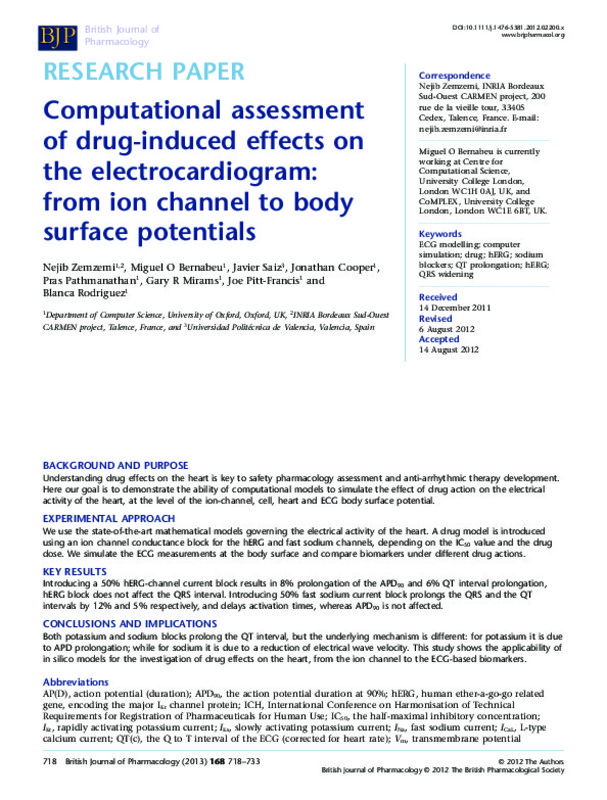JavaScript is disabled for your browser. Some features of this site may not work without it.
Buscar en RiuNet
Listar
Mi cuenta
Estadísticas
Ayuda RiuNet
Admin. UPV
Computational assessment of drug-induced effects on the electrocardiogram: from ion channel to body surface potentials
Mostrar el registro sencillo del ítem
Ficheros en el ítem
| dc.contributor.author | Zemzemi, Nejib
|
es_ES |
| dc.contributor.author | Bernabeu, Miguel O.
|
es_ES |
| dc.contributor.author | Saiz Rodríguez, Francisco Javier
|
es_ES |
| dc.contributor.author | Cooper, Jonathan
|
es_ES |
| dc.contributor.author | Pathmanathan, Pras
|
es_ES |
| dc.contributor.author | Mirams, Gary R.
|
es_ES |
| dc.contributor.author | Pitt-Francis, Joe
|
es_ES |
| dc.contributor.author | Rodríguez, Blanca
|
es_ES |
| dc.date.accessioned | 2013-12-26T11:41:55Z | |
| dc.date.issued | 2013-01 | |
| dc.identifier.issn | 0007-1188 | |
| dc.identifier.uri | http://hdl.handle.net/10251/34675 | |
| dc.description.abstract | BACKGROUND AND PURPOSE Understanding drug effects on the heart is key to safety pharmacology assessment and anti-arrhythmic therapy development. Here our goal is to demonstrate the ability of computational models to simulate the effect of drug action on the electrical activity of the heart, at the level of the ion-channel, cell, heart and ECG body surface potential. EXPERIMENTAL APPROACH We use the state-of-the-art mathematical models governing the electrical activity of the heart. A drug model is introduced using an ion channel conductance block for the hERG and fast sodium channels, depending on the IC50 value and the drug dose. We simulate the ECG measurements at the body surface and compare biomarkers under different drug actions. KEY RESULTS Introducing a 50% hERG-channel current block results in 8% prolongation of the APD90 and 6% QT interval prolongation, hERG block does not affect the QRS interval. Introducing 50% fast sodium current block prolongs the QRS and the QT intervals by 12% and 5% respectively, and delays activation times, whereas APD90 is not affected. CONCLUSIONS AND IMPLICATIONS Both potassium and sodium blocks prolong the QT interval, but the underlying mechanism is different: for potassium it is due to APD prolongation; while for sodium it is due to a reduction of electrical wave velocity. This study shows the applicability of in silico models for the investigation of drug effects on the heart, from the ion channel to the ECG-based biomarkers. | es_ES |
| dc.description.sponsorship | The authors would like to thank Drs Philippe Moireau, Miguel Fernandez and Elsie Phe from INRIA Paris-Rocquencourt for their work on the anatomical models and meshes. We are also grateful to Professors Dominique Chapelle and Jean-Frederic Gerbeau heads of MACS and REO teams respectively, in INRIA Paris-Rocquencourt for providing us with the meshes. This study was supported financially by the European Commission preDiCT grant (DG-INFSO224381). BR holds a Medical Research Council Career Development Award. | en_EN |
| dc.language | Inglés | es_ES |
| dc.publisher | Wiley-Blackwell | es_ES |
| dc.relation | European Commission preDiCT grant [DG-INFSO224381] | es_ES |
| dc.relation.ispartof | British Journal of Pharmacology | es_ES |
| dc.rights | Reserva de todos los derechos | es_ES |
| dc.subject | ECG modelling | es_ES |
| dc.subject | Computer simulation | es_ES |
| dc.subject | Drug | es_ES |
| dc.subject | HERG | es_ES |
| dc.subject | Sodium blockers | es_ES |
| dc.subject | QT prolongation | es_ES |
| dc.subject | QRS widening | es_ES |
| dc.subject.classification | TECNOLOGIA ELECTRONICA | es_ES |
| dc.title | Computational assessment of drug-induced effects on the electrocardiogram: from ion channel to body surface potentials | es_ES |
| dc.type | Artículo | es_ES |
| dc.identifier.doi | 10.1111/j.1476-5381.2012.02200.x | |
| dc.relation.projectID | info:eu-repo/grantAgreement/EC/FP7/224381/EU/Computational Prediction of Drug Cardiac Toxicity/ | en_EN |
| dc.rights.accessRights | Abierto | es_ES |
| dc.contributor.affiliation | Universitat Politècnica de València. Departamento de Ingeniería Electrónica - Departament d'Enginyeria Electrònica | es_ES |
| dc.description.bibliographicCitation | Zemzemi, N.; Bernabeu, MO.; Saiz Rodríguez, FJ.; Cooper, J.; Pathmanathan, P.; Mirams, GR.; Pitt-Francis, J.... (2013). Computational assessment of drug-induced effects on the electrocardiogram: from ion channel to body surface potentials. British Journal of Pharmacology. 168(3):718-733. https://doi.org/10.1111/j.1476-5381.2012.02200.x | es_ES |
| dc.description.accrualMethod | S | es_ES |
| dc.relation.publisherversion | http://onlinelibrary.wiley.com/doi/10.1111/j.1476-5381.2012.02200.x/pdf | es_ES |
| dc.description.upvformatpinicio | 718 | es_ES |
| dc.description.upvformatpfin | 733 | es_ES |
| dc.type.version | info:eu-repo/semantics/publishedVersion | es_ES |
| dc.description.volume | 168 | es_ES |
| dc.description.issue | 3 | es_ES |
| dc.relation.senia | 243033 | |
| dc.identifier.pmid | 22946617 | en_EN |
| dc.identifier.pmcid | PMC3579290 | |
| dc.contributor.funder | Medical Research Council, Reino Unido | es_ES |








